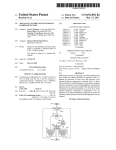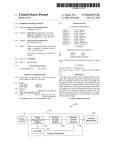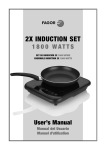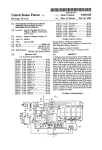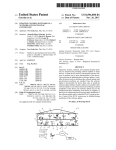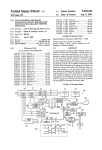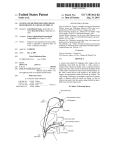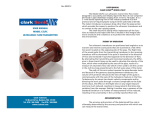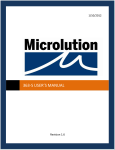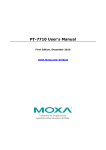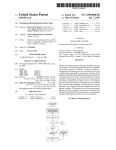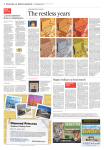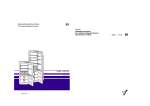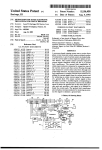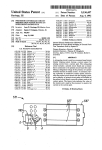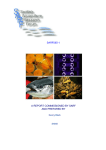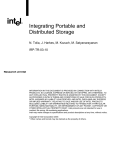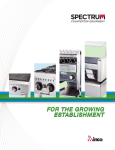Download Water heater with temporary capacity increase
Transcript
US008485138B2 (12) United States Patent (10) Patent No.: Leeland (54) (45) Date of Patent: WATER HEATER WITH TEMPORARY CAPACITY INCREASE (75) Inventor: 9/1987 Yoshida et a1. 9/1987 Bohan, Jr. 4,734,658 A 3/1988 Bohan, Jr. i (73) Assignee: Honeywell International Inc., Morristown N] (US) ’ 3 et 31' 4,834,284 A 5/1989 Vandermeyden 4,984,981 A 1/1991 Pottebaum 4,986,468 A l/ 1991 Deisinger 5,007,156 A 4/1991 Hurtgen 5,103,078 A 4/1992 Boykin et a1. Subject' to any disclaimer,~ the term of this 2 301111813: patent 1s extended or adjusted under 35 5,660,328 A 8/1997 Momber U.S.C. 154(b) by 1280 days. (Continued) (21) Appl. No.: 12/270,783 FOREIGN PATENT DOCUMENTS _ (22) F1led: NOV. 13, 2008 (65) Jul. 16, 2013 4,692,598 A 4,696,639 A Shanna Lorraine Leeland, St. Paul, MN (Us) ( * ) Notice: US 8,485,138 B2 EP 0356609 3/1990 Ep 0699316 7/1999 Prior Publication Data Us 2010/0116224 A1 (Continued) May 13, 2010 OTHER PUBLICATIONS U.S. Appl. No. 10/911,151, ?led Aug. 3, 2004. (51) Int. Cl. F24H 9/20 (52) (58) (2006.01) (Continued) US. Cl. _ _ _ USPC .................... .. 122/1422, 122/1421, 700/300 Prlmary Exam/net * John K Fnswe, Jr Field of Classi?cation Search USPC ........ .. 122/141, 14.2, 14.21, 14.22; 700/299, Assistant Examiner * Matthew W Jellett (74) Attorney, Agent, or Firm i Seager Tufte & Wickhem 700/300; 236/51 LLC. See application ?le for complete search history. (57) (56) References Cited A water heater may be con?gured to temporarily increase its hot water capacity by heating water to a higher boost tem U.S. PATENT DOCUMENTS 3,847,350 A 11/1974 Thompson 3,849,350 4,324,944 RE30,936 4,333,002 4,467,178 4,508,261 4,511,790 4,568,821 4,588,875 A A E A A A A A A 11/1974 4/1982 5/1982 6/1982 8/1984 4/1985 4/1985 2/1986 5/1986 ABSTRACT perature. In some instances, the water heater may include a main controller that can accept a boost request from a remote Matsko Weihrich et a1. Kmetz et a1. Kozak Swindle Blank Kozak Boe Kozaketal. controller, and thus may temporarily provide additional hot water capacity without, for example, requiring a homeowner to go down to the basement, out to the garage, or wherever the water heater happens to be to make manual adjustments to the water heater settings. 17 Claims, 6 Drawing Sheets ___________ _ _ H Tamer Mode euman Selecled_|k—74 ___________ _ _ ll Maln Controller la In Normal Mode Enter Basil. ll' Already In Boost Mode, Cancel Euosl Request Temporary S at Point _ 5°. F Temporary Dllferentlal = 0 Temporary Set Point = Last Set Point 9 10' F or Max Dlal Set Polnt If Operellng Set Palm = Maximum Temperature 92 | 1 ---- I ---- --. Boost Mode lndiceled Set Poim when Boost is Pressed, Flash ‘Max’ Temp. Set Exit Boost Mode 8r Return 00 Lall [96 N° PelntReachud'l Y" Set POlnl [as US 8,485,138 B2 Page 2 US. PATENT DOCUMENTS 5,779,143 5,797,358 5,896,089 5,968,393 5,975,884 6,053,130 6,059,195 6,069,998 6,075,923 6,208,806 6,212,894 6,261,087 6,271,505 6,293,471 6,350,967 6,363,218 6,375,087 RE37,745 6,560,409 6,633,726 6,701,874 6,795,644 6,861,621 6,880,493 6,934,862 6,936,798 6,955,301 6,959,876 7,088,238 7,117,825 7,221,862 7,252,502 A A A A 7/ 1998 8/1998 4/ 1999 10/ 1999 Michaud et al. Brandt et al. BoWles Demaline A A 11/1999 Dugger 4/2000 Shellenberger A A A 5/ 2000 Adams et al. 5/2000 Barnes et al. 6/ 2000 Wu B1 3/2001 Langford B1 B1 B1 B1 B1 B1 4/ 2001 7/2001 8/2001 9/2001 2/2002 3/ 2002 B1 4/2002 Day et al. E B2 6/ 2002 Brandt et al. 5/ 2003 Troost, IV B2 10/ 2003 Bradenbaugh B1 3/ 2004 Schultz et al. B2 9/ 2004 Bradenbaugh Brown et al. Bird et al. Henderson Stettin et al. Scott LoWenstein et al. B2 B2 B2 B2 B2 B2 B2 3/ 2005 4/ 2005 8/2005 8/ 2005 10/ 2005 11/2005 8/ 2006 B2 10/ 2006 Phillips B1 B2 Ghent Clifford Sharood et al. Moreno Munsterhuis et al. Chian et al. KaraoguZ et al. 5/ 2007 Miller et al. 8/ 2007 Mun sterhuis 7,317,265 B2 1/2008 Chian et al. 8,165,726 B2 * 8,176,881 B2* 4/2012 Nordberg et al. ........... .. 700/300 5/2012 Arensmeier et al. ..... .. 122/14.22 2004/ 0042772 A1 3/2004 Whitford et al. 2004/ 0267385 A1 12/2004 Lingemann 2005/0077368 2005/0147401 2005/0147402 2005/0150967 2006/0243816 2007/0023333 4/2005 7/2005 7/2005 7/2005 11/2006 A1 A1 A1 A1 A1 A1 2007/0034169 A1 2007/0191994 A1 2007/0246551 A1 2007/0295823 A1 2008/0023564 A1 Zak et al. Baxter Baxter Chapman, Jr. et al. Teti 2/2007 Mouhebaty et al. 2/2007 Phillips 8/2007 Patterson et al. 10/2007 Phillips et al. 12/2007 Yamada et al. 1/2008 Hall 2008/0188995 A1 8/2008 Hotton et al. 2009/0139466 A1* 6/2009 Takayama 2010/0206869 A1* 8/2010 122/14.2 Nelson et al. ............... .. 219/494 FOREIGN PATENT DOCUMENTS GB JP JP 2211331 8264469 2008008548 6/1999 10/1996 1/2008 OTHER PUBLICATIONS Lennox, “Network Control Panel, User’s Manual,” 18 pages, Nov. 1999. Moog, “M3000 Control System, RTEMP 8, Remote 8-Channel Tem perature Controller With CanOpen Interface,” 6 pages, Nov. 2004. * cited by examiner US. Patent Jul. 16, 2013 Sheet 1 of6 US 8,485,138 B2 26 10\ 24 20 22 figure 1 US. Patent Jul. 16, 2013 Sheet 2 of6 US 8,485,138 B2 /30 Main Controller @181 38-4 Gas Control Block 36 i 1? Remote Controller mm W42 figure 2 US. Patent Jul. 16, 2013 Sheet 3 of6 US 8,485,138 B2 / \ 50 m 46 \ 48 \44 / figure 3 US. Patent Jul. 16, 2013 Sheet 4 of6 54 US 8,485,138 B2 K-SG R figure 4 US. Patent Jul. 16, 2013 Sheet 5 0f 6 US 8,485,138 B2 Provide a Maximum Temperature Set Point l Accept from the Remote Controller an Operating Temperature Set Point ll Operate the Water Heater in Accordance with the Operating Temperature Set Point ll Accept from the Remote Controller a Boost Request ll Operate the Water Heater in Accordance with a Boost Temperature Set Point figure 5 r72 US. Patent Jul. 16, 2013 Sheet 6 of6 US 8,485,138 B2 ___________ _ ._ .1 VBoost Mode Button SelectedJl-——74 L- _ _ H _ - _ I _ _ _ _ _. ._ Main Controller Receives Boost Mode Message l lf Main Controller is in Normal Mode Enter Boost, if Already in Boost ~—7B Mode, Cancel Boost Request _ i Boost Mode Enabled, Start/Continue #80 Counter to Track Time in Boost 84L L86 Temporary Set Point =150°F Tempma'y Set P°mt : Last Set Point + 10° F or Max Dial Set Point 90L ____ _1_____[88 Temporary Differential = 0 __--| | 92~l r_- If Operating Set Point ‘11 = Maximum Temperature 4 l l : — — w — — ~ H — — -— — -1 L Boost Mode indicated J Set Point when Boost - II 94 9e Boost [ Temp. Set No II‘ |_ _'§ trisieg'f I351‘ _Mf§_ ._ Exit Boost Mode Point Reached? Yes or Time & Return‘ to Last Set Point Expired figure 6 US 8,485,138 B2 1 2 WATER HEATER WITH TEMPORARY CAPACITY INCREASE available Within a relatively short time frame. For example, several extra house guests may Wish to shoWer in the morning, TECHNICAL FIELD relatively short time period. One Way to accommodate this This disclosure relates generally to Water heaters and more particularly to Water heaters that are con?gured to provide a ever, it may not be very e?icient to run an oversiZed Water causing a temporary increased demand for hot Water in a situation is to initially install an oversiZed Water heater. HoW heater all the time to accommodate occasional and short-term demands for increased hot Water. temporary capacity increase. BACKGROUND SUMMARY Water heaters are commonly used in homes, businesses and just about any establishment having the need for heated The present disclosure relates generally to Water heaters and more particularly to Water heaters that are con?gured to provide a temporary hot Water capacity increase. In one illus Water. In many cases, a Water heater is con?gured to heat Water in a Water heater tank using a gas-?red burner, an electric heater or some other heater element. When demand trative embodiment, this may be accomplished by tempo rarily increasing the temperature of the Water in the Water for hot Water arises (e.g., someone turns on a faucet to run a heater tank. In some instances, the Water heater may include shoWer), fresh, cold or ambient temperature Water typically enters the Water heater tank and “pushes out” or supplies the hotter Water. When the temperature of the Water in the Water heater falls beloW a temperature set point, either though the a main controller that can accept a boost request from a 20 mere passage of time or as a result of a hot Water draW, the Water heater typically activates a heater element to restore the temperature of the Water in the tank back to the temperature set point. To help reduce cycling of the Water heater, a temperature differential is often employed, Where the Water heater does not activate the heater element until the temperature of the Water in the Water heater falls beloW the temperature set point by at least a temperature differential amount. The desired 25 disposed proximate the Water tank. A main controller may be provided that is con?gured to control the heat source. The 30 in accordance With a particular temperature differential as is actually activated can be referred to as the second tempera 35 sponds to the temperature differential. A conventional Water heater typically has at least one heat ing element or “heater,” such as a gas-?red and/or electric burner. To take advantage of the “heat-rises” principle, the 40 other user, for additional hot Water capacity and may com municate a resultant boost request to the main controller. In some instances, the boost request may include instructions to increase to a boo st temperature set point that is higher than the normal operating temperature set point. In some cases, the temperature differential temperature may be reduced While in the boost mode. closure may be found in a Water heater that includes a Water 45 tank and a gas burner that is disposed proximate the Water tank. A communicating gas valve may be con?gured to con trol gas How to the gas burner. The communicating gas valve may include a maximum temperature set point and an oper 50 With a particular temperature differential as described above. Water heater. When temperature signals from the temperature sensor indicate that the Water temperature is beloW the second temperature set point, for example When the Water tempera ture is beloW about 1200 F., the controller may turn on the heater element and the Water Within the Water heater begins to heat. After some time, the Water temperature Within the Water heater tank may increase back to the ?rst temperature set described above. In some cases, a remote controller may be con?gured to accept a request, such as from a homeoWner or Another illustrative but non-limiting example of the dis heating of Water, the controller often receives signals related to the temperature of the Water, oftentimes from a temperature sensor that is thermally engaged With the Water Within the main controller may include a maximum temperature set point and an operating temperature set point, and may operate ture set point and the temperature at Which the heater element heater is often located at or near the bottom of the Water heater tank. Each Water heater typically also has at least one ther mo stat or controller for controlling the heater. To facilitate the temporarily change the set point of the Water heater. In an illustrative but non-limiting example, a Water heater is provided that includes a Water tank and a heat source that is temperature set point can be referred to as the ?rst tempera ture set point, Where the difference betWeen the ?rst tempera ture set point and the second temperature set point corre remote controller or the like, and in response, may tempo rarily increase the temperature of the Water in the Water heater tank to provide additional hot Water Without requiring a user to, for example, go doWn to the basement, out to the garage, or Wherever the Water heater happens to be to manually and ating temperature set point and may operate in accordance In some cases, a remote controller may be con?gured to accept a request for additional hot Water capacity from a user, point, Which, for example, may be about 1400 F. At this point, and to communicate a resultant boost request to the commu the controller may cause the heater element to reduce its heat output or, alternatively, causes the heater element to turn off. nicating gas valve. In some instances, the boost request may 55 include instructions to increase to a boost temperature set This heating cycle may begin again When the Water tempera point that is higher than the normal operating temperature set ture Within the Water heater tank drops beloW the second point. In some cases, the temperature differential temperature may be reduced While in the boost mode. temperature set point. Water heaters are typically available in a variety of differ ent siZes so that a particular home or building may be equipped With a Water heater having a thermal capacity, or Another illustrative but non-limiting example of the dis 60 quantity of suf?ciently heated Water, that is su?icient for normal conditions expected for the particular home or build may be provided, as Well as operating temperature set point. ing. HoWever, special circumstances, such as having over night visitors, may mean that there may be a temporary, larger than normal demand for hot Water. Typically, the increased demand is accompanied by a need to have increased hot Water closure may be found in a method of operating a Water heater that has a communicating gas valve having a main controller and a remote controller. A maximum temperature set point The main controller may operate the Water heater in accor 65 dance With the operating temperature set point. If a boost request is accepted from the remote controller, the main con troller may temporarily operate the Water heater in accor US 8,485,138 B2 3 4 dance with a boost temperature set point. In some cases, the unit 18. In some instances, however, temperature sensor 28 may instead be located behind gas control unit 18. To accom temperature differential temperature may be reduced while in the boost mode. modate this, water tank 12 may include an aperture or recess (not illustrated) that is siZed and con?gured to accept tem The above summary is not intended to describe each and every disclosed embodiment or every implementation of the perature sensor 28. In some cases, gas control unit 18 may be in communica disclosure. The Description that follows more particularly exempli?es various illustrative embodiments. tion with a main controller (not seen in FIG. 1) that provides gas control unit 18 with appropriate command instructions. In some cases, gas control unit 18 may itself incorporate the main controller. FIG. 2 is a schematic diagram showing how BRIEF DESCRIPTION OF THE FIGURES a remote controller may provide instructions to gas control unit 18. FIG. 2 shows a main controller 30 and a remote The following description should be read with reference to the drawings. The drawings, which are not necessarily to scale, depict selected embodiments and are not intended to controller 32 that is in communication with main controller limit the scope of the disclosure. The disclosure may be more 30. In some cases, remote controller 32 may communicate completely understood in consideration of the following detailed description of various embodiments in connection with the accompanying drawings, in which: wirelessly with main controller 30. In some instances, remote controller 32 may be electrically connected to main controller 30 via wires such as low voltage wiring, similar to the 24 volt wiring used to connect HVAC thermostats to furnaces and FIG. 1 is a schematic view of an illustrative but non-limit other HVAC equipment. These are only example connections ing water heater in accordance with the present disclosure; FIG. 2 is a schematic block view of an illustrative control 20 system that may be used with the water heater of FIG. 1; FIG. 3 is a schematic view of an illustrative main controller that may be used in the control system of FIG. 2; FIG. 4 is a schematic view of an illustrative remote con troller that may be used in the control system of FIG. 2; 25 FIG. 5 is a ?ow diagram showing an illustrative but non some cases, main controller 30 may have an I/O block 34 that limiting example of a method that may be carried out via the control system of FIG. 2; and accepts signals from a temperature sensor 28 (FIG. 1), remote controller 32 and/ or any other suitable device or component. FIG. 6 is a ?ow diagram showing an illustrative but non limiting example of a method that may be carried out via the control system of FIG. 2. While the invention is amenable to various modi?cations and alternative forms, speci?cs thereof have been shown by way of example in the drawings and will be described in detail. It should be understood, however, that the intention is that may facilitate communication between the main control ler 30 and the remote controller 32. As noted above, and in some instances, main controller 30 may be integrated into gas control unit 18, while in other cases main controller 30 may be external to gas control unit 18 but in communication with gas control unit 18. It is contemplated that main controller 30 may have several components. In 30 I/ O block 34 may accommodate control signals from remote controller 32. Main controller 30 may include a microproces sor 36 that may be con?gured to accept appropriate signals from I/O block 34 and determine appropriate output signals 35 that can be outputted via I/O block 34 to other components within gas control unit 18 (FIG. 1), remote controller 32 and/or any other suitable device or component. While not not to limit the invention to the particular illustrative embodi ments described. On the contrary, the intention is to cover all illustrated, microprocessor 36 may also include memory. In some cases, main controller 30 may also include a Gas Control block 38. Gas Control block 38 may receive com modi?cations, equivalents, and alternatives falling within the spirit and scope of the invention. 40 mand instructions from microprocessor 36 and may in turn DESCRIPTION provide appropriate instructions to an electrically controlled gas valve disposed within or controlled by the gas control unit The following description should be read with reference to the drawings, in which like elements in different drawings are 18. The illustrative remote controller 32 may also have several components. In some instances, remote controller 32 may numbered in like fashion. The drawings, which are not nec 45 essarily to scale, depict selected embodiments and are not intended to limit the scope of the invention. Although examples of construction, dimensions, and materials are illustrated for the various elements, those skilled in the art will recogniZe that many of the examples provided have suitable include an I/O block 40 and a user interface 42. U0 block 40 may, for example, receive information from the user interface 42 and provide corresponding information to main controller 30. When provided, user interface 42 may take any desired 50 alternatives that may be utiliZed. The disclosure relates to heating water, and as such may In some instances, user interface 42 may be con?gured to permit a user to request additional hot water. For example, a include fossil fuel-?red water heaters, electrically heated water heaters, boilers and the like. Merely for illustrative purposes, the drawings show a fossil fuel-?red water heater. 55 However, it is contemplated that the any type of water heater may be used. face 42. It is contemplated that remote controller 32 may be 60 line 14 and is heated by a gas burner 24. The resulting heated water exits through a hot water line 16. A gas control unit 18 regulates gas ?ow from a gas source 20 through a combustion gas line 22 and into gas burner 24. A ?ue 26 permits combus tion byproducts to safely exit. Water heater 10 may include a temperature sensor 28. In some cases, temperature sensor 28 may enter water tank 12 at a location exterior to gas control homeowner may anticipate that due to a larger number of occupants, hot water may run low at a particular time of day. In some cases, the homeowner may preemptively instruct water heater 10 (FIG. 1) to provide additional hot water capacity to remedy the expected shortcoming via user inter FIG. 1 shows a schematic view of an illustrative but non limiting water heater 10. Water heater 10 includes a water tank 12. Cold water enters water tank 12 through a cold water form, and may include a display and/or one or more buttons that a user may use to enter information. 65 con?gured to permit a homeowner or other user to make a request for additional hot water capacity for a particular period of time. In other cases, it is contemplated that remote controller 32 may be programmed to provide additional hot water capacity on a regular or programmed basis, perhaps at a particular time of day and/ or only on certain day(s). Turning now to FIG. 3, an illustrative but non-limiting example of gas control unit 18 is shown. Gas control unit 18 US 8,485,138 B2 5 6 may include a temperature set point setting device 44. In some setting device 44 (FIG. 3). In some cases, the operating tem perature set point is set at the main controller 30, and not via instances, temperature set point setting device 44 may include the remote controller 32. a rotatable knob 46 having an indicator line or arroW 48. The rotatable knob 46 may rotate relative to a temperature scale 50 that is printed or otherWise disposed on an outer surface of gas Under normal operating conditions, main controller 30 may operate Water heater 10 (FIG. 1) in accordance With a particular temperature differential value. The temperature control unit 18. In some cases, temperature set point setting device 44 may provide gas control unit 18 With an operating temperature set point. In some instances, particularly if gas differential may be a numerical difference betWeen a tem perature at Which gas burner 24 is activated and a temperature at Which gas burner 24 is terminated or stopped. For example, if main controller 30 is programmed With a temperature dif ferential value of say 100 F. and a temperature set point of 120° F., gas burner 24 may be activated When a Water tem control unit 18 is in communication With a remote controller such as remote controller 32 (FIG. 2), temperature set point setting device 44 may provide gas control unit 18 With a maximum temperature set point, While the remote controller may provide the operating temperature set point. In some instances, both an operating temperature set point and a maxi perature indicated by temperature sensor 28 (FIG. 1) falls to 1 10° F., and may run until the Water temperature rises to 120° F. HoWever, in some illustrative embodiments, if a home mum temperature set point may be set using one or more dials or the like at the gas control unit 18. While a rotating knob 46 oWner or other user requests additional hot Water via remote is shoWn, it is contemplated that any suitable user interface may be provided for setting an operating temperature set point and/ or a maximum temperature set point, as desired. FIG. 4 shoWs an illustrative but non-limiting example of a remote controller 52 that may be considered as being an controller 32 (FIG. 2) or otherWise, main controller 30 may operate using a loWer temperature differential or even a Zero 20 differential, if desired. In an illustrative embodiment, When remote controller 32 (FIG. 2) instructs main controller 30 (FIG. 2) that additional illustrative embodiment of remote controller 32 (FIG. 2). hot Water capacity has been requested, main controller 30 Remote controller 52 may be mounted or otherWise disposed may determine a boost temperature set point that may repre Within a home or building, at a location that is remote from 25 sent an increase to the operating temperature set point. For Water heater 10 (FIG. 1). In some cases, for example, remote controller 52 may be Wall-mounted Within a living space, proximate or incorporated into a HVAC controller such as a thermostat. In some instances, it is contemplated that remote controller 52 may be disposed in or near a bathroom, as a bath 30 or shoWer is often a large consumer of hot Water. Regardless of Where remote controller 52 is disposed, illus point setting device 44 (FIG. 3). trative remote controller 52 may include one or more of a display 54, an UP arroW 56, a DOWN arroW 58, and/or selection buttons 60 and 62. In some cases, it is contemplated that display 54 may be a touch screen display such as a touch screen LCD display, and as such, remote controller 52 may 35 not include any physical buttons. In some instances, for 40 cation of Whether or not Water heater 10 is in a boost mode period. A boost mode period is a time period during Which a 45 ods are contemplated and permissible. In some cases, main controller 30 may maintain the boost temperature set point otherWise be available When operating at the operating tem 50 In some cases, UP arroW 56 and/or DOWN arroW 58 may be used by the user to raise or loWer an operating temperature set point. In some instances, remote controller 52 may accept an operating temperature set point from a user and may com municate the operating temperature set point to main control ler 30 (FIG. 2). Main controller 30 may then operate Water heater 10 in accordance With the operating temperature set 55 point provided by the remote controller 52, provided that certain safety parameters are met. For example, main control ler 30 (FIG. 2) may operate in accordance With the operating 60 temperature set point as long as the operating temperature set point does not exceed a predetermined temperature safety maximum temperature set point set by temperature set point inde?nitely, until receiving a subsequent signal from remote controller 32 (FIG. 2) to return to the operating temperature set point. When operating in accordance With the boost tem perature set point, the Water heater 10 may operate normally but With a higher temperature set point and thus attempts to heat all of the Water in the Water tank, and not just Water around a top portion of the tank. This can signi?cantly increase the hot Water capacity of the Water heater 10 during a boost period. FIG. 5 is a How diagram shoWing an illustrative but non limiting example of a method that may be carried out in the operation of Water heater 10 (FIG. 1). Control begins at block 64, Where a maximum temperature set point is provided. In some cases, this may be done using temperature set point setting device 44 (FIG. 3) or though some otheruser interface. limit such as 160° F., or perhaps 1540 F. In some cases, main controller 30 may operate in accordance With the operating temperature set point as long as the operating temperature set point provided by remote controller 52 does not exceed the normal operating temperature set point. In some cases, main controller 30 may operate in accordance With the boost tem perature set point, turning gas burner 24 on and off as appro priate to maintain the Water at the boost temperature set point for a predetermined length of time. For example, main con troller 30 may maintain the boost temperature set point for a period of time up to about 2 hours, although other time peri user has requested, sometimes via remote controller 52, an elevated Water temperature Within Water heater 10 in order to obtain more thermal energy from Water heater 10 than may perature set point. In some embodiments, main controller 30 (FIG. 2), upon receiving a boost request from remote controller 32 (FIG. 2), may operate gas burner 24 (FIG. 1) until the boost tempera ture set point has been reached. Once the boost temperature set point has been reached, the boost periodmay be ended and main controller 30 may in some cases revert back to the example, display 54 may provide a graphical representation of an operating temperature set point, the current status of Water heater 10 (FIG. 1), i.e., Whether Water heater 10 is in a draW period, recovery period or standby, or any other desired information. In some cases, display 54 may provide an indi example, the boost temperature set point may be 10° F. higher than the operating temperature set point, but it Will be appre ciated that other temperature increases may also be employed. In some instances, the boost temperature set point may be limited by safety limits and/or by the maximum temperature set point set by, for example, the temperature set Alternatively, or in addition, a maximum temperature set 65 point may be hard coded. At block 66, an operating tempera ture set point may be accepted, such as from the remote controller 32 (FIG. 2) or through a dial or the like on the main US 8,485,138 B2 7 8 controller 30. Main controller 30 (FIG. 2) may operate Water heater 10 in accordance With the operating temperature set accepted from, for example, the remote controller 32 (FIG. 2). determination, and a corresponding display such as that shoWn at block 88, may also take place even if, at decision block 82, the normal operating temperature set point Was greater than 140°. Returning back to decision block 82, if the normal operat In some cases, main controller 30 (FIG. 2) may calculate or otherWise determine a boost temperature set point, and may passes to block 84 Where the boost temperature set point is set point, as shoWn at block 68. Control passes to block 70, Where a boost request is ing temperature set point is greater than 140° F., control equal to 150° F. That is, if the normal operating temperature set point is greater than 140° F., the boost temperature set point is not increased by 10° F., but rather is only raised to operate Water heater 10 (FIG. 1) in accordance With the boost temperature set point as shoWn at block 72. In some instances, Water heater 10 (FIG. 1) may be operated in accordance With the boost temperature set point for a predetermined length of 150° F. From blocks 84 and 88, control is passed to block 90. In time, and sometimes set the temperature differential to Zero or block 90, main controller 30 (FIG. 2) may temporarily set the any other desired temperature differential. Reducing the tem perature differential to Zero may cause the main controller 30 temperature differential equal to Zero or some other reduced to immediately activate the heater element of the Water heater. In some cases, Water heater 10 may be operated in accordance With a boost temperature set point only if the boost tempera ture set point falls beloW particular safety limits and/ or beloW value as desired. This may trigger operation of gas burner 24 (FIG. 1) sooner than it Would otherWise be started, thereby the maximum temperature set at block 64. In some cases, the main controller 30 may adjust the boost temperature set point to be Within particular safety limits and/ or Within the maxi 20 mum temperature set at block 64. FIG. 6 is a How diagram shoWing another illustrative but non-limiting example of a method that may be carried out in the operation of Water heater 10 (FIG. 1). In FIG. 6, it can be seen that certain steps or operations, indicated by solid lines, may be manifested Within main controller 30 (FIG. 2), While 25 other steps or operations, indicated by dashed lines, may be manifested Within remote controller 32, but this is not required. At block 74, it can be seen that a homeoWner or other user has pressed a Boost button or otherWise activated a boost In some cases, the main controller 30 may include an 30 6,955,301, Which are incorporated herein by reference. The disclosure should not be considered limited to the particular examples described above, but rather should be 35 cesses, as Well as numerous structures to Which the invention 40 some cases, main controller 30 may also start a counter or 45 decision block 82, a determination is made Whether the nor perature differential; and 50 temperature set point is set equal to the normal operating temperature set point plus 10° P. (where 10° F. is selected for maximum temperature set point. If the operating temperature set point is already equal to the maximum temperature set point When the boost button is pressed, remote controller 32 (FIG. 2) may provide a graphical or other indication of this a heat source disposed proximate the Water tank; a main controller disposed proximate the Water tank, the main controller con?gured to control the heat source, the main controller including a maximum temperature set point and an operating temperature set point, the main controller operating in accordance With a particular tem boost mode. Control is then passed to decision block 82. At illustrative purposes only) or the maximum temperature set point, Whichever is less. Control then passes to block 88, Where the operating temperature set point is compared to the can be applicable Will be readily apparent to those of skill in the art upon revieW of the instant speci?cation. What is claimed is: 1. A Water heater system comprising: a Water tank; timer that can be used to set a maximum time period for the mal operating temperature set point is at or below 1400 P. (where 140° F. is selected for illustrative purposes only). If the operating temperature set point is less than or equal to 140° F. at decision block 82, control passes to block 86 Where a boost understood to cover all aspects of the invention as set out in the attached claims. Various modi?cations, equivalent pro (FIG. 2) is operating in accordance With an operating tem perature set point, main controller 30 enters a boost mode. If main controller 30 is already in boost mode When the Boost button is pushed, the main controller may cancel the boost mode, return to operating in accordance With an operating temperature set point, and return to block 74. At block 80, main controller 30 enables the boost mode. In anti-stacking control algorithm to help prevent stacking in the Water tank, such as described in Us. Pat. No. 6,560,409 and mode via remote controller 32 (FIG. 2). A boost button may, for example, correspond to one of the selection buttons 60 or 62 shoWn on remote controller 52 (FIG. 4), or may be a touch button on a touch screen display. At block 76, main controller 30 receives the boost request. Control passes to block 78, Where if main controller 30 initiating the heating cycle sooner. At block 92, remote con troller 32 (FIG. 2) may provide a graphical or other indication that Water heater 10 (FIG. 1) is in a boost mode. Control is then passed to block 94, Where main controller 30 determines if the boost temperature set point has been reached, or if the timer started in block 80 has expired. In the illustrative embodiment, if either event has occurred, control passes to block 96 Where the main controller 30 exits the boost mode and returns to operating at the operating temperature set point. If the boost temperature set point has not been reached and if the timer started in block 80 has not expired, control reverts to block 80, Where the timer is continued. 55 a remote controller in communication With the main con troller and con?gured to accept a request from a user for additional hot Water capacity, resulting in the remote controller communicating a boost request to the main controller, Wherein the boost request results in the main controller temporarily operating in accordance With a boost temperature set point that is higher than the oper ating temperature set point; Wherein the main controller, upon receiving the boost 60 request from the user, activates a timer and operates the heat source in accordance With the boost temperature set condition (such as ?ash “MAX”), telling the user that no point for a predetermined length of time measured by the timer; and boost is available because the Water heater 10 (FIG. 1) is already operating at the maximum temperature set point. In Wherein the main controller sets the boo st temperature set point at a temperature that is a predetermined amount some cases, this may cause the user to adjust the maximum 65 temperature set point using, for example, temperature set point setting device 44 (FIG. 3). It is contemplated that this above the operating temperature set point as long as the resulting boo st temperature set point does not exceed the maximum temperature set point of the main controller. US 8,485,138 B2 9 10 2. The Water heater system of claim 1, Wherein the heat temperature that is a predetermined amount above the oper source includes a fossil fuel burner and the main controller is ating temperature set point limited by the maximum tempera included in a communicating gas valve. 3. The Water heater system of claim 1, Wherein the remote controller is con?gured to accept an operating temperature set ture set point. 1 0. The Water heater system of claim 6, Wherein the remote controller provides the controller of the communicating gas valve With the operating temperature set. point, and to communicate the operating temperature set point to the main controller. 4. The Water heater system of claim 1, Wherein the main controller, upon receiving the boost request, operates the heat 11. The Water heater system of claim 6, Wherein the com municating gas valve, upon receiving the boost request, pro vides gas to the gas burner until the boost temperature set source until the boost temperature set point is reached and is point is reached and is to for the predetermined length of time. controlled to for the predetermined length of time. 5. The Water heater system of claim 1, Wherein the main controller, upon receiving the boost request, operates the heat 12. The Water heater system of claim 6, Wherein the com municating gas valve, upon receiving the boost request, pro vides gas to the gas burner for the predetermined length of time. source for the predetermined length of time unless a subse quent signal to stop the boost request is received from a user via the remote controller. 6. A Water heater system comprising: 13. The Water heater system of claim 6, Wherein the com municating gas valve, upon receiving the boost request, pro vides gas to the gas burner for the predetermined length of time unless a subsequent signal to stop the boost request is a Water tank; a gas burner disposed proximate the Water tank; a communicating gas valve con?gured to control gas How to the gas burner, the communicating gas valve including 20 received from a user via the remote controller. a controller With a maximum temperature set point and 14. A method of operating a Water heater having a commu nicating gas valve and a remote controller, the method com an operating temperature set point, the controller of the prising the steps of: communicating gas valve operating in accordance With a particular temperature differential; and storing a maximum temperature set point and an operating temperature set point; operating the Water heater in accordance With the operating temperature set point; a remote controller con?gured to accept a request for addi tional hot Water from a user and to communicate a result ant boost request to the controller of the communicating gas valve, Wherein in response, the controller of the communicating gas valve operates in accordance With a boo st temperature set point that is higher than the oper accepting from the remote controller a boost request for additional hot Water capacity; 30 ating temperature set point; Wherein upon accepting a request for additional hot Water from a user, the controller of the communicating gas valve initiates a timer and operates in accordance With the boost temperature set point for a predetermined mum temperature set point; 35 length of time as determined by the timer; and Wherein, the communicating gas valve, in response to receiving the boost request from the remote controller, sets the boost temperature set point at a temperature that is a predetermined amount above the operating tempera ture set point. 7. The system of claim 1, Wherein the main controller is con?gured to: compare the boost temperature set point to the maximum temperature set point; and set the boost temperature set point to the maximum tem perature set point if the boost temperature set point is 40 municating gas valve may, in response to receiving the boost request from the remote controller, reduce the temperature differential and thus provide gas to the gas burner sooner. 9. The Water heater system of claim 6, Wherein the com municating gas valve sets the boost temperature set point at a activating a timer; temporarily operating the Water heater in accordance With a boost temperature set point for a predetermined time period as determined by the timer after the boo st request for additional hot Water capacity is accepted; and returning to operate the Water heater in accordance With the operating temperature set point after the predetermined time period expires. 15. The method of claim 14, Wherein operating the Water heater in accordance With the boost temperature set point includes operating the Water heater With a reduced tempera 45 ture differential. 16. The method of claim 14 Wherein the operating tem perature set point is accepted from the remote controller. 17. The method of claim 14, further comprising: comparing the operating temperature set point plus the higher than the maximum temperature set point. 8. The Water heater system of claim 6, Wherein the com setting the boost temperature set point to the operating temperature set point plus an offset limited by the maxi 50 offset to the maximum temperature set point; and setting the boost temperature set point to the maximum temperature set point if the operating temperature set point plus the offset is higher than the maximum tem perature set point. * * * * *













